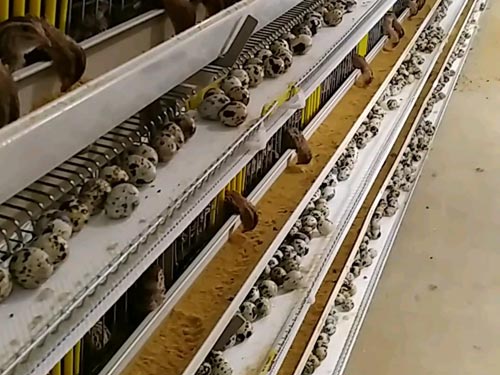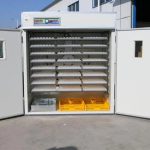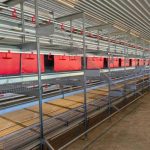Breeding pullet quail in stackable quail cage
Pullet quail refers to the stage from 15 to 40 days old. During this period, the growth rate is high, especially for bones, muscles, digestive, and reproductive systems. The primary tasks in managing this stage include controlling the standard body weight, ensuring normal sexual maturity, and conducting strict selection and immunization.
Lighting
During the breeding stage, quail require reduced lighting compared to the brooding period, with 10-12 hours of natural light being sufficient. In seasons with longer natural daylight, windows in stackable quail cage may need to be covered to maintain the prescribed light duration.
Humidity and ventilation
It is crucial to keep the indoor air fresh but avoid drafts, and the floor must be kept dry. During winter, ensure proper insulation and ventilate when temperatures are slightly higher at noon. The suitable humidity range is 55%-60%.
Temperature
In the early rearing period, the temperature should be maintained at 23-27°C, and in the mid to late period, it can be kept at 20-22°C.
Feed Control
For breeding quail and egg-laying quail, to ensure their future breeding value and egg production performance, it is best to house male and female quail separately and restrict the feeding of female breeding quail, starting from 28 days old. This not only reduces costs and prevents premature sexual maturity but also improves the quantity, quality, and qualified rate of eggs. Methods for restricted feeding include:
- Controlling the protein content in the diet to 20%.
- Restricting the feed amount to 80% of the standard feed quantity.
By 40 days old, about 2% of breeding and egg-laying quail may start laying eggs, but most will begin between 45-55 days old. Before this, all preventive measures and deworming should be completed, and groups should be transferred in a timely manner. Prepare the grown-up quail house, feed, etc., before transferring. Handle the quail gently and maintain a quiet environment during the transfer.
Quail around one month old can be sexed based on appearance. Except for breeding males, other males and lower-quality females can be moved to fattening cages for market preparation.


Management of stacked quail cage for egg laying breeding quail
Temperature
Suitable indoor temperature is key for high and stable production, generally maintained at 18-24°C. Below 15°C, egg production decreases, and below 10°C, egg production stops and may cause deaths. Solutions include increasing stocking density and adding insulation. In summer, temperatures above 35°C reduce feed intake, cause panting, and decrease egg production, requiring lower stocking densities and increased ventilation.
Lighting
Lighting serves two purposes: enabling quail to feed and stimulating the pituitary gland through the eyes to increase hormone secretion, promoting sexual maturity and egg production. Initially and during peak production, quail require 14-16 hours of light, extending to 17 hours later. Light intensity should be 2.5-3W per square meter, with attention to the bottom layer of stacked cages.
Humidity
The ideal relative humidity for egg-laying quail is 50%-55%. Quail need to dissipate heat, and excretion increases humidity. Excessive humidity promotes microbial growth, affecting health and egg production.
Maintaining a Quiet Environment
Quail are skittish and easily startled, leading to running, jumping, and flying in cages, which can decrease egg production and increase malformed eggs. Careful handling, avoiding disturbances from vehicles or strangers, is essential.
Daily Management
Daily tasks include cleaning and recording. Feed and water troughs should be cleaned daily, and manure should be removed 1-2 times daily. Disinfection pools should be at the entrance, with disinfectant pans inside. Prevent intrusion by rodents and birds. Records should include the number of quail, egg production, feed intake, deaths, eliminations, weather conditions, and personnel on duty.


Management of grown-up quail in quail stacking cage
Grown-up quail are typically those older than 40 days. The aim is to produce high-quality, high-yield breeding eggs, chicks, and edible eggs. Grown-up quail can be classified into breeding quail and egg-laying quail, with differences in breeding techniques, cage specifications, stocking density, and feeding standards. However, their daily management is generally similar.
Selection of Breeding Quail
When selecting breeding quail, they should be alert, attractive, have glossy feathers, well-developed muscles, thin skin, and a small, round head with a short beak and long neck. Specific requirements for females and males include:
Females selection
- Healthy, active, with a large appetite and no diseases.
- High egg production capacity, with an annual egg rate of over 80% for egg-type quail and 75% for meat-type quail. Monthly egg production should be 24-27 or more.
- Larger body size. Mature females should weigh 140-160 grams, and meat quail should be heavier. A larger abdominal volume, with a pelvic gap of two finger widths and a pelvic tip to sternum gap of three finger widths, indicates high egg production.
This method is effective in the first laying year; older quail may have larger abdomens but lower egg production.
Males selection
Vocal, strong, with broad chests, weighing 115-130 grams. The cloaca should be bright red and swollen, producing white foam when pressed, indicating readiness for mating. The claws should be able to open fully to prevent slipping during mating, which could reduce fertilization rates.
Ratio of Males to Females and Utilization Period
The ratio of males to females varies based on breeding or production needs, commonly 1 male to 4 or 4.5 females. The correct ratio is crucial for ensuring a high fertilization rate. Insufficient males lead to lower fertilization rates, while too many males increase costs and can cause competition among males.
The utilization period for male quail is one year, while breeding females can be used for 0.5 to 2 years, depending on egg production, egg weight, fertilization rate, economic benefits, and breeding value. In practice, egg-type breeding quail are typically used for 8 months for breeding, and meat-type females for 6 months.
Feeding and nutrition for grown-up quail in quail stacking cage
- Egg-laying quail require complete feed, with high-quality demands, especially for energy and protein levels. Energy should reach 2750-2800 kcal/kg, and protein should be 19.3-19.5%. In winter, animal and vegetable oils can be added.
- Each egg-laying quail consumes about 20-24 grams of feed and 45 ml of water daily, varying with egg production and seasonal changes.
- Increasing feeding frequency impacts egg production rates. Even if feed and water are available, it is beneficial to mix the feed or add fresh feed 4-5 times daily.



